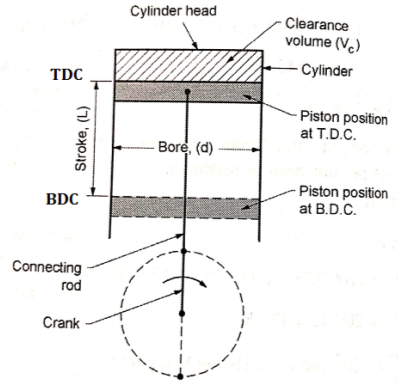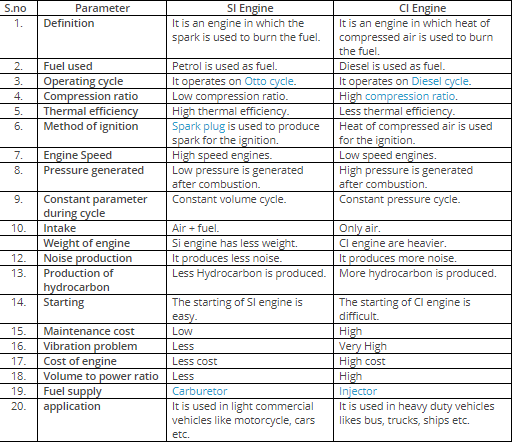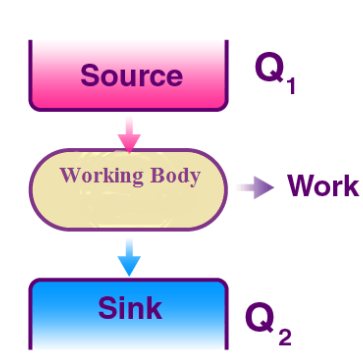Unit - 2
Introduction to IC Engines and RAC
Q1) Explain the terminology of I C engine
A1) Terminology Used in I.C. Engines

Q2) Explain the Working of Two stroke S. I. Engine
A2) FIRST STROKE:
SECOND STROKE:
Q3) Difference Between SI Engine and CI Engine in
A3)

Q4) Define the term Refrigeration
A4) It is a well-known fact that heat flows in the direction of decreasing temperature, i.e., from a high temperature region to a low temperature region.
But the reverse process (i.e., heat transfer from low to high temperature) cannot occur by itself (Clausius Definition of Second Law). This process requires a special device called Refrigerator.
Working
In the refrigeration cycle, there are five basic components: a fluid refrigerant; a compressor, a condenser coil, an evaporator coil, and an expansion device. The compressor constricts the refrigerant vapor, raising its pressure, and pushes it into the coils on the outside of the refrigerator. When the hot gas in the coils meets the cooler air temperature of the kitchen, it becomes a liquid. Now, in the liquid form at high pressure, the refrigerant cools down as it flows into the coils inside the freezer and the fridge. The refrigerant absorbs the heat inside the fridge, cooling down the air. Lastly, the refrigerant evaporates and then flows back to the compressor, where the cycle repeats itself.
Q5) Give some application of refrigeration
A5) Applications
Q6) Explain the Concept of heat pump.
A6) Heat Pump
A heat pump is basically a heat engine run in the reverse direction. In other words, a heat pump is a device that is used to transfer heat energy to a thermal reservoir. They are often used to transfer thermal energy by absorbing heat from a cold space and releasing it to a warmer one.
Heat pumps transfer heat from cold body to a hot body by the expense of mechanical energy supplied to it by an external agent. The cold body is cooled more and more. A heat pump generally comprises four key components which include a condenser, a compressor, an expansion valve and an evaporator. The working substance used in these components is called refrigerant.
Some of the most common examples of a heat pump include freezers and air conditioners, or other heating, ventilating devices. As for the applications, heat pumps are used either for heating or cooling.
How to find the Coefficient of Performance of a Heat Pump
When we talk about heat pump efficiencies, we basically have to deal with a few key terms such as;
The performance of the heat pump is expressed by the coefficient of performance (K).
K = Heat extracted from the cold body / Work needed to transfer it to the hot body
K = Heat extracted by work done
K = QL / W
From 1st law of thermodynamics for the cyclic process ΔU = 0
ΔQ = ΔW
W = QH – QL
K = QL / QH – QL

Q7) Describe the Air conditioning term
A7) Definition of Air Conditioning:
Air conditioning can be defined as the treatment of indoor air in order to control certain conditions required for human comfort. The desirable conditions may be temperature, humidity, dust particle level, odor level, and air motion.
It is known that the physical properties of air can be controlled by cooling, heating, humidification, and dehumidification. These processes may be employed to maintain specific conditions desirable for comfort. Thus, simultaneous control of temperature, humidity, air motion, and cleanliness are known as air conditioning.
Q8) Define the Applications of Refrigeration
A8) The applications of refrigeration can be grouped into following four major equally important areas:
Q9) Explain the dry bulb, wet bulb
A9) Dry Bulb Temperature - Tdb
The Dry Bulb temperature, usually referred to as "air temperature", is the air property that is most commonly used. When people refer to the temperature of the air, they are normally referring to the dry bulb temperature.
The Dry Bulb Temperature refers basically to the ambient air temperature. It is called "Dry Bulb" because the air temperature is indicated by a thermometer not affected by the moisture of the air.
Dry-bulb temperature - Tdb, can be measured using a normal thermometer freely exposed to the air but shielded from radiation and moisture. The temperature is usually given in degrees Celsius (oC) or degrees Fahrenheit (oF). The SI unit is Kelvin (K). Zero Kelvin equals to -273oC.
The dry-bulb temperature is an indicator of heat content and is shown along the bottom axis of the psychrometric chart or along the left side of the Mollier diagram. Constant dry bulb temperatures appear as vertical lines in the psychrometric chart or horizontal lines in the Mollier diagram.
Wet Bulb Temperature - Twb
The Wet Bulb temperature is the adiabatic saturation temperature.
Wet Bulb temperature can be measured by using a thermometer with the bulb wrapped in wet muslin. The adiabatic evaporation of water from the thermometer bulb and the cooling effect is indicated by a "wet bulb temperature" lower than the "dry bulb temperature" in the air.
The rate of evaporation from the wet bandage on the bulb, and the temperature difference between the dry bulb and wet bulb, depends on the humidity of the air. The evaporation from the wet muslin is reduced when air contains more water vapor.
The Wet Bulb temperature is always between the Dry Bulb temperature and the Dew Point. For the wet bulb, there is a dynamic equilibrium between heat gained because the wet bulb is cooler than the surrounding air and heat lost because of evaporation. The wet bulb temperature is the temperature of an object that can be achieved through evaporative cooling, assuming good air flow and that the ambient air temperature remains the same.
By combining the dry bulb and wet bulb temperature in a psychrometric chart or Mollier diagram the state of the humid air can be determined. Lines of constant wet bulb temperatures run diagonally from the upper left to the lower right in the Psychrometric chart.